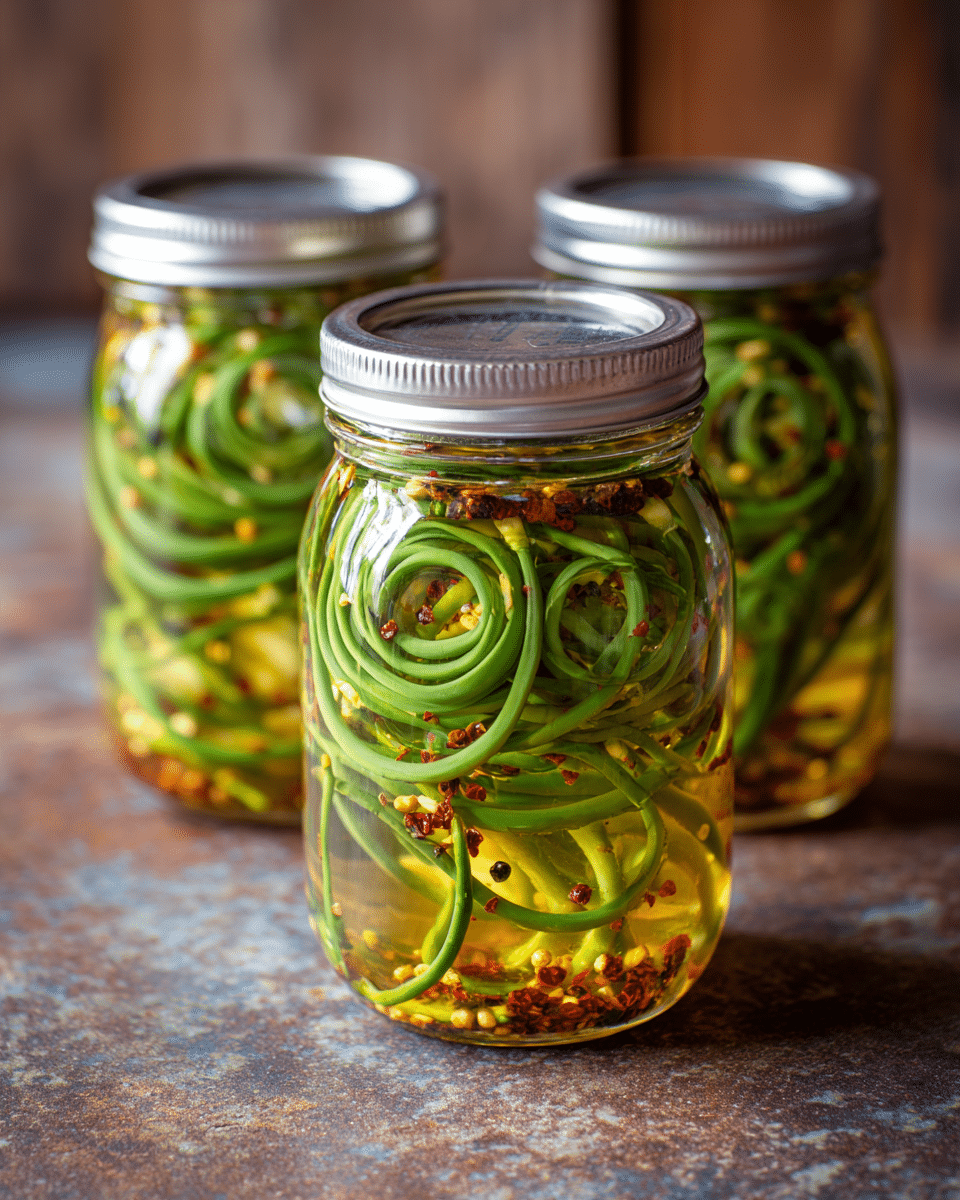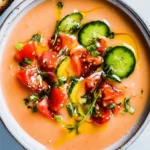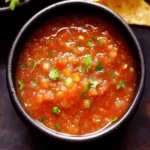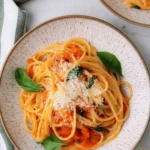Pickled garlic scapes are a vibrant and flavorful way to preserve the fleeting bounty of garlic scape season. These curly green shoots, harvested from the tops of garlic plants, offer a mild garlic flavor with a satisfying crunch. When pickled, they transform into a zesty snack or condiment with a balance of tangy vinegar, subtle sweetness, and a garlicky bite.
FULL RECIPE
Ingredients
- 1 pound garlic scapes, trimmed to fit jars
- 2 cups white vinegar (5% acidity)
- 1 cup water
- 1 tablespoon kosher salt
- 1 tablespoon sugar (optional, for balanced flavor)
- 1 teaspoon black peppercorns
- 1 teaspoon mustard seeds
- 1/2 teaspoon red pepper flakes (optional, for heat)
- 2 bay leaves
- 2 sprigs fresh dill (optional)
- 2 pint-sized glass jars with lids, sterilized
Directions
- Rinse the garlic scapes and trim them to fit upright in your jars. Curlier pieces can be coiled into the jars if needed.
- In a medium saucepan, combine vinegar, water, salt, and sugar. Bring to a boil, stirring until salt and sugar dissolve completely.
- Meanwhile, divide the peppercorns, mustard seeds, red pepper flakes (if using), bay leaves, and dill between the two jars.
- Pack the trimmed garlic scapes tightly into the jars, standing them upright or coiling as needed.
- Pour the hot brine over the scapes, leaving about 1/2 inch of headspace at the top.
- Tap jars gently on the counter to release any air bubbles, then seal with sterilized lids.
- Let the jars cool to room temperature before refrigerating.
- For best flavor, allow the scapes to pickle in the fridge for at least 5–7 days before enjoying.
- Keep refrigerated and consume within 3 months for optimal flavor and texture.
Nutrition Facts
- Calories: 10
- Total Fat: 0g
- Saturated Fat: 0g
- Trans Fat: 0g
- Cholesterol: 0mg
- Sodium: 150mg
- Total Carbohydrates: 2g
- Dietary Fiber: 1g
- Sugars: 0g
- Protein: 0g
- Vitamin C: 2% DV
- Calcium: 1% DV
- Iron: 1% DV
Flavor Profile and Texture
Pickled garlic scapes are a harmonious blend of sharp, tangy, savory, and subtly sweet notes. The vinegar brine provides acidity, while optional sugar balances the sharpness. The scapes themselves retain a firm crunch even after sitting in the brine for weeks, much like pickled green beans or asparagus. Their flavor is less pungent than raw garlic, offering a more approachable garlicky taste that’s bright and complex. The optional addition of spices like mustard seed, dill, or red pepper flakes further enhances the aromatic qualities, giving each bite a layered depth.
Nutritional Benefits of Pickled Garlic Scapes
While pickling slightly reduces the vitamin content due to heat and acid exposure, garlic scapes still retain dietary fiber and trace nutrients such as calcium, vitamin C, and iron. They are naturally low in calories and fat, making them an excellent guilt-free snack or side. Garlic scapes also contain beneficial sulfur compounds like allicin, which have antimicrobial and antioxidant properties. Though some of these compounds are diminished in the pickling process, small amounts may remain, offering modest health benefits when included in a balanced diet.
Creative Variations and Flavor Twists
The base pickling recipe for garlic scapes is easily customizable. Adding fresh dill or tarragon creates a traditional herbal flavor, while chili flakes or sliced jalapeños can introduce a spicy twist. Swapping out white vinegar for apple cider vinegar adds a subtle fruitiness, and rice vinegar lends a gentler, sweeter acidity. A few slices of lemon or orange peel can brighten the mix, while whole cloves or shallots added to the jar create a more complex flavor profile. These tweaks can be tailored to personal preference or matched to specific cuisines.
Serving Ideas and Culinary Uses
Pickled garlic scapes are incredibly versatile and can be used in countless ways. Chop them finely and mix into potato salad, egg salad, or coleslaw for a zingy bite. Add them to cheese boards or antipasto platters for a unique twist on classic pickled accompaniments. They make a zesty garnish for Bloody Marys, or they can be wrapped around charcuterie for an eye-catching and flavorful addition. For a quick flavor boost, slice and toss them into grain bowls, tacos, or even homemade pizzas. Their crunch and acidity lift heavy or rich dishes with contrast and freshness.
Drink Pairings and Complementary Flavors
Because of their sharp and tangy nature, pickled garlic scapes pair best with beverages that offer cleansing, balancing qualities. Dry white wines such as Sauvignon Blanc or a crisp Pilsner beer can cut through the acidity and enhance the herbal notes. For non-alcoholic options, lightly sparkling water with citrus or cold-brew tea with mint makes an excellent match. In dishes, they pair well with rich, fatty foods like cured meats, aged cheeses, or roasted pork, as the vinegar and salt help refresh the palate.
Storage and Shelf Life Tips
Refrigerated pickled garlic scapes stored in sterilized jars will last up to three months, maintaining their bright flavor and crispness. It’s essential to use clean utensils when retrieving scapes from the jar to prevent introducing bacteria. If you’re looking to preserve them for longer, a water bath canning method can make the pickles shelf-stable for up to a year, though this process requires stricter sanitation and acid-level monitoring. Once opened, always keep the jars refrigerated and tightly sealed to extend their usability.
Best Practices for Pickling Success
For the best pickling results, always start with fresh, young garlic scapes that are firm and vibrant green. Use jars that have been sterilized to avoid contamination, and pack the scapes tightly without crushing them to ensure even brine coverage. Boiling the brine ensures salt and sugar dissolve fully and flavors meld properly. Letting the jars cool completely before refrigerating helps prevent condensation and spoilage. While you can sample them within a day or two, waiting at least five days will significantly enhance the depth of flavor.
Sourcing and Seasonality
Garlic scapes are typically available at farmers’ markets and specialty produce stores in late spring to early summer. They are rarely found in large supermarkets due to their short season and limited commercial cultivation. Growing your own garlic provides a reliable source of scapes, making them a rewarding bonus harvest before the garlic bulbs mature. Because of their limited availability, many home cooks choose to pickle large batches when scapes are in season to enjoy them throughout the year.
Sustainability and No-Waste Cooking
Pickling garlic scapes aligns with sustainable and no-waste cooking principles. In many garlic-growing operations, scapes are discarded to direct energy toward bulb formation. By harvesting and preserving them, you’re utilizing a nutritious, flavorful part of the plant that would otherwise go unused. This practice not only reduces food waste but also adds variety and value to your pantry. It reflects a mindful approach to eating—one that honors the entire plant and the resources used to grow it.
Advertisement
Conclusion
Pickled garlic scapes offer a tangy, crunchy, and endlessly versatile way to capture the fleeting essence of early summer’s garlic harvest. From their satisfying texture to their bright, garlicky zing, these pickles elevate everyday meals and serve as a flavorful accent across cuisines. With countless opportunities for customization, they appeal to both traditional and adventurous palates. Whether you’re preserving a homegrown harvest or grabbing a few bundles from the farmers’ market, this simple recipe turns a seasonal ingredient into a year-round delight worth savoring.






